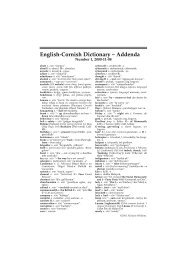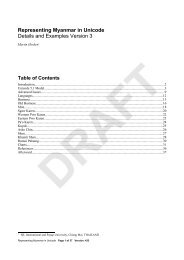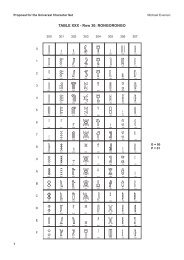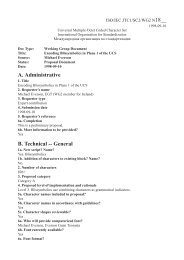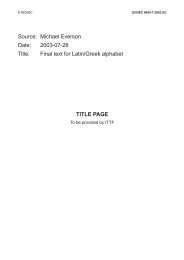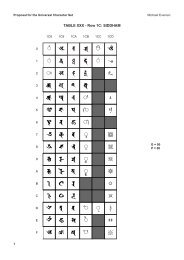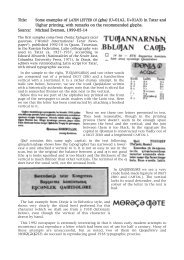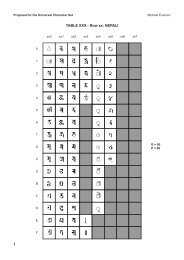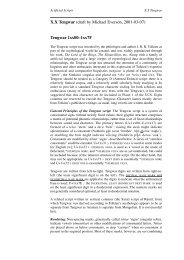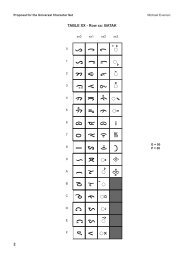ISO/IEC JTC1/SC2/WG2 N3xxx L2/07-xxx - Evertype
ISO/IEC JTC1/SC2/WG2 N3xxx L2/07-xxx - Evertype
ISO/IEC JTC1/SC2/WG2 N3xxx L2/07-xxx - Evertype
Create successful ePaper yourself
Turn your PDF publications into a flip-book with our unique Google optimized e-Paper software.
2a. Has contact been made to members of the user community (for example: National Body, user groups of the script or characters, other<br />
experts, etc.)?<br />
Yes.<br />
2b. If YES, with whom?<br />
John Baines, Jaromír Málek, Wolfgang Schenkel, Nigel Strudwick, Jochen Hallof, Marc-Jan Nederhof, Serge Rosmarduc, Hans van<br />
den Berg, Lee Collins, Richard Cook.<br />
2c. If YES, available relevant documents<br />
http://titus.fkidg1.uni-frankfurt.de/unicode/iranian/3tagung.htm<br />
3. Information on the user community for the proposed characters (for example: size, demographics, information technology use, or<br />
publishing use) is included?<br />
Egyptologists and many enthustiasts worldwide.<br />
4a. The context of use for the proposed characters (type of use; common or rare)<br />
To write Egyptian.<br />
4b. Reference<br />
5a. Are the proposed characters in current use by the user community?<br />
Yes.<br />
5b. If YES, where?<br />
By scholars and enthusiasts worldwide.<br />
6a. After giving due considerations to the principles in the P&P document must the proposed characters be entirely in the BMP?<br />
No.<br />
6b. If YES, is a rationale provided?<br />
6c. If YES, reference<br />
7. Should the proposed characters be kept together in a contiguous range (rather than being scattered)?<br />
Yes.<br />
8a. Can any of the proposed characters be considered a presentation form of an existing character or character sequence?<br />
No.<br />
8b. If YES, is a rationale for its inclusion provided?<br />
8c. If YES, reference<br />
9a. Can any of the proposed characters be encoded using a composed character sequence of either existing characters or other proposed<br />
characters?<br />
No.<br />
9b. If YES, is a rationale for its inclusion provided?<br />
9c. If YES, reference<br />
10a. Can any of the proposed character(s) be considered to be similar (in appearance or function) to an existing character?<br />
No. There is no question of unifying Egyptian Hieroglyphs with other scripts or symbols. U+2625 ANKH is not the same character as<br />
EGYPTIAN HIEROGLYPH S034, despite the origin of the former in the latter.<br />
10b. If YES, is a rationale for its inclusion provided?<br />
10c. If YES, reference<br />
11a. Does the proposal include use of combining characters and/or use of composite sequences (see clauses 4.12 and 4.14 in <strong>ISO</strong>/<strong>IEC</strong><br />
10646-1: 2000)?<br />
No.<br />
11b. If YES, is a rationale for such use provided?<br />
11c. If YES, reference<br />
11d. Is a list of composite sequences and their corresponding glyph images (graphic symbols) provided?<br />
No.<br />
11e. If YES, reference<br />
12a. Does the proposal contain characters with any special properties such as control function or similar semantics?<br />
No.<br />
12b. If YES, describe in detail (include attachment if necessary)<br />
13a. Does the proposal contain any Ideographic compatibility character(s)?<br />
No.<br />
13b. If YES, is the equivalent corresponding unified ideographic character(s) identified?<br />
17





